With 67 confirmed satellites, Jupiter has the largest system of moons in the Solar System. The greatest of these are the four major moons of Io, Europa, Ganymede and Callisto – otherwise known as the Galilean Moons. Named in honor of their founder, these moons are not only comparable in size to some planets (such as Mercury), they are also some of the few places outside of Earth where liquid water exists, and perhaps even life.
But it is Callisto, the fourth and farthest moon of Jupiter, that may be the most rewarding when it comes to scientific research. In addition to the possibility of a subsurface ocean, this moon is the only Galilean far enough outside of Jupiter’s powerful magnetosphere that it does not experience harmful levels of radiation. This, and the prospect of finding life, make Callisto a prime candidate for future exploration.
Discovery and Naming:
Along with Io, Europa and Ganymede, Callisto was discovered in January of 1610 by Galileo Galilei using a telescope of his own design. Like all the Galilean Moons, it takes its name from one of Zeus’ lovers in classic Greek mythology. Callisto was a nymph (or the daughter of Lycaon) who was associated with the goddess of the hunt, Artemis.
The name was suggested by German astronomer Simon Marius, apparently at the behest of Johannes Kepler. However, Galileo initially refused to use them, and the moons named in his honor were designed as Jupiter I through IV, based on their proximity to their parent planet. Being the farthest planet from Jupiter, Callisto was known as Jupiter IV until the 20th century, by which time, the names suggested by Marius were adopted.
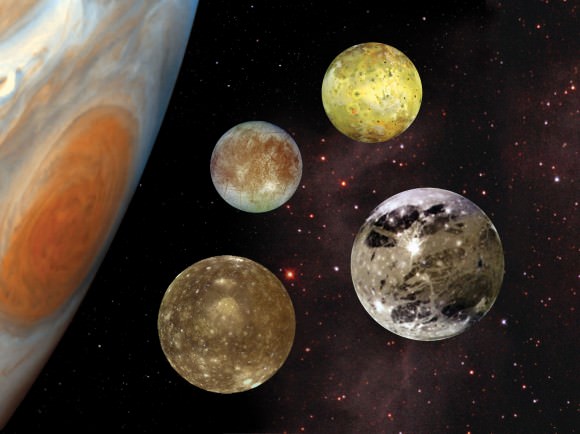
Size, Mass and Orbit:
With a mean radius of 2410.3 ± 1.5 km (0.378 Earths) and a mass of 1.0759 × 1023 kg (0.018 Earths), Callisto is the second largest Jupiter’s moons (after Ganymede) and the third largest satellite in the solar system. Much like Ganymede, it is comparable in size to Mercury – being 99% as large – but due to its mixed composition, it has less than one-third of Mercury mass.
Callisto orbits Jupiter at an average distance (semi-major axis) of 1,882,700 km. It has a very minor eccentricity (0.0074) and ranges in distance from 1,869,000 km at periapsis to 1,897,000 km at apoapsis. This distance, which is far greater than Ganymede’s, means that Callisto does not take part in the mean-motion resonance that Io, Europa and Ganymede do.
Much like the other Galileans, Callisto’s rotation is synchronous with its orbit. This means that it takes the same amount of time (16.689 days) for Callisto to complete a single orbit of Jupiter and a single rotation on its axis. Its orbit is very slightly eccentric and inclined to the Jovian equator, with the eccentricity and inclination changing over the course of centuries due to solar and planetary gravitational perturbations.
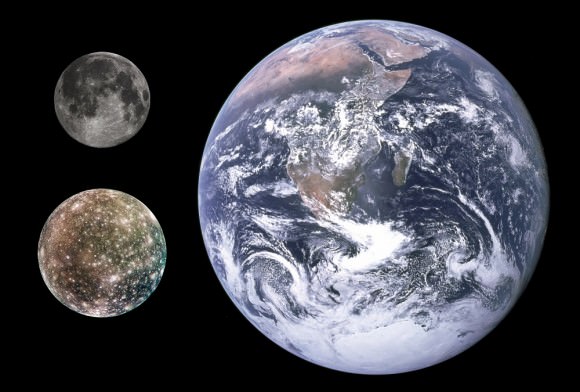
Unlike the other Galileans, Callisto’s distant orbit means that it has never experienced much in the way of tidal-heating, which has had a profound impact on its internal structure and evolution. Its distance from Jupiter also means that the charged particles from Jupiter’s magnetosphere have had a very minor influence on its surface.
Composition and Surface Features:
The average density of Callisto, at 1.83 g/cm3, suggests a composition of approximately equal parts of rocky material and water ice, with some additional volatile ices such as ammonia. Ice is believed to constitute 49-55% of the moon, with the rock component likely made up of chondrites, silicates and iron oxide.
Callisto’s surface composition is thought to be similar to its composition as a whole, with water ice constituting 25-50% of its overall mass. High-resolution, near-infrared and UV spectra imaging have revealed the presence of various non-ice materials, such as magnesium and iron-bearing hydrated silicates, carbon dioxide, sulfur dioxide, and possibly ammonia and various organic compounds.
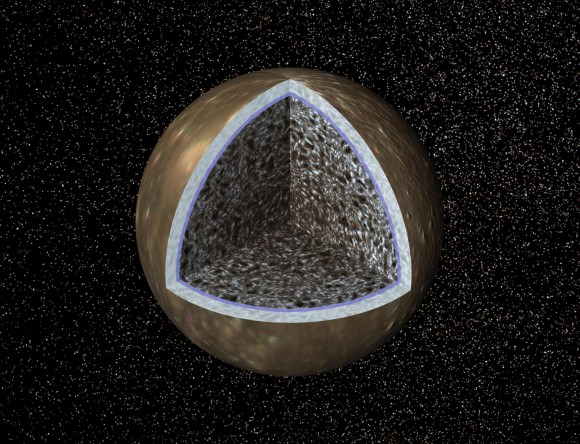
Beneath the surface is an icy lithosphere that is between 80-150 m thick. A salty ocean 50–200 km deep is believed to exist beneath this, thanks to the presence of radioactive elements and the possible existence of ammonia. Evidence of this ocean include Jupiter’s magnetic field, which shows no signs of penetrating Callisto’s surface. This suggests a layer of highly conductive fluid that is at least 10 km in depth. However, if this water contains ammonia, which is more likely, than it could be up to 250-300 km.
Beneath this hypothetical ocean, Callisto’s interior appears to be composed of compressed rocks and ices, with the amount of rock increasing with depth. This means, in effect, that Callisto is only partially differentiated, with a small silicate core no larger than 600 km (and a density of 3.1-3.6 g/cm³) surrounded by a mix of ice and rock.
Spectral data has also indicated that Callisto’s surface is extremely heterogeneous at the small scale. Basically, the surface consists of small, bright patches of pure water ice, intermixed with patches of a rock–ice mixture, and extended dark areas made of a non-ice material.
Compared to the other Galilean Moons, Callisto’s surface is quite dark, with a surface albedo of about 20%. Another difference is the nature of its asymmetric appearance. Whereas with the other Galileans, the leading hemisphere is lighter than the trailing one, with Callisto the opposite is true.

An immediately obvious feature about Callisto’s surface is the ancient and heavily cratered nature of it. In fact, the surface is the most cratered in the Solar System and is almost entirely saturated by craters, with newer ones having formed over older ones. What’s more, impact craters and their associated structures are the only large features on the surface. There are no mountains, volcanoes or other endogenic tectonic features.
Callisto’s impact craters range in size from 0.1 km to over 100 km, not counting the multi-ring structures. Small craters, with diameters less than 5 km, have simple bowl or flat-floored shapes, whereas those that measure 5–40 km usually have a central peak.
Larger impact features, with diameters that range from 25–100 km have central pits instead of peaks. Those with diameters over 60 km can have central domes, which are thought to result from central tectonic uplift after an impact.
The largest impact features on Callisto’s surface are multi-ring basins, which probably originated as a result of post-impact concentric fracturing which took place over a patch of lithosphere that overlay a section of soft or liquid material (possibly a patch of the interior ocean). The largest of these are Valhalla and Asgard, whose central, bright regions measure 600 and 1600 km in diameter (respectively) with rings extending farther outwards.
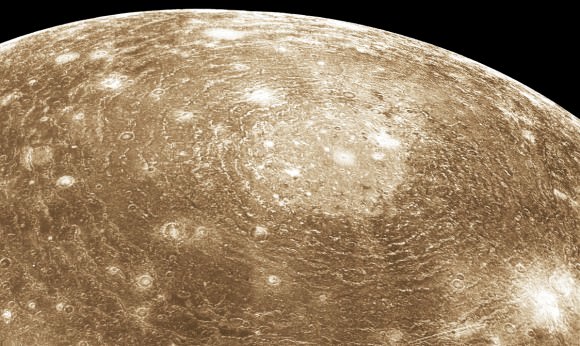
The relative ages of the different surface units on Callisto can be determined from the density of impact craters on them – the older the surface, the denser the crater population. Based on theoretical considerations, the cratered plains are thought to be ~4.5 billion years old, dating back almost to the formation of the Solar System.
The ages of multi-ring structures and impact craters depend on chosen background cratering rates, and are estimated by different researchers to vary between 1 and 4 billion years of age.
Atmosphere:
Callisto has a very tenuous atmosphere composed of carbon dioxide which has an estimated surface pressure of 7.5 × 10-¹² bar (0.75 micro Pascals) and a particle density of 4 × 108 cm-3. Because such a thin atmosphere would be lost in only about 4 days, it must be constantly replenished, possibly by slow sublimation of carbon dioxide ice from Callisto’s icy crust.
While it has not been directly detected, it is believed that molecular oxygen exists in concentrations 10-100 times greater than CO². This is evidenced by the high electron density of the planet’s ionosphere, which cannot be explained by the photoionization of carbon dioxide alone. However, condensed oxygen has been detected on the surface of Callisto, trapped within its icy crust.
Habitability:
Much like Europa and Ganymede, and Saturn’s moons of Enceladus, Mimas, Dione, Titan, the possible existence of a subsurface ocean on Callisto has led many scientists to speculate about the possibility of life. This is particularly likely if the interior ocean is made up of salt-water, since halophiles (which thrive in high salt concentrations) could live there.
In addition, the possibility of extra-terrestrial microbial life has also been raised with respect to Callisto. However, the environmental conditions necessary for life to appear (which include the presence of sufficient heat due to tidal flexing) are more likely on Europa and Ganymede. The main difference is the lack of contact between the rocky material and the interior ocean, as well as the lower heat flux in Callisto’s interior.
In essence, while Callisto possesses the necessary pre-biotic chemistry to host life, it lacks the necessary energy. Because of this, the most likely candidate for the existence of extra-terrestrial life in Jupiter’s system of moons remains Europa.
Exploration:
The first exploration missions to Callisto were the Pioneer 10 and 11 spacecrafts, which conducted flybys of the Galilean moon in 1973 and 1974, respectively, But these missions provided little additional information beyond what had already learned through Earth-based observations. In contrast, the Voyager 1 and 2 spacecraft, which conducted flybys of the moon in 1979, managed to image more than half the surface and precisely measured Callisto’s temperature, mass and shape.
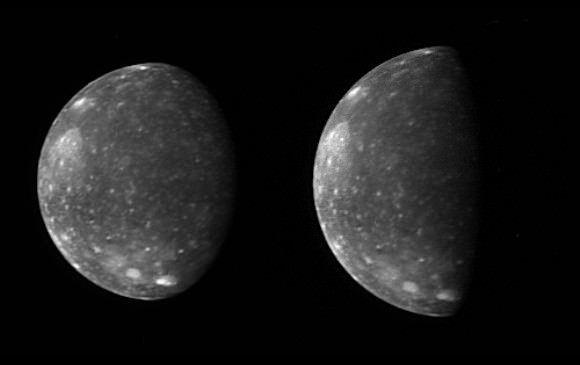
Further exploration took place between 1994 and 2003, when the Galileo spacecraft performed eight close flybys with Callisto. The orbiter completed the global imaging of the surface and delivered a number of pictures with a resolution as high as 15 meters. In 2000, while en route to Saturn, the Cassini spacecraft acquired high-quality infrared spectra of the Galilean satellites, including Callisto.
In February–March 2007, while en route to Pluto, the New Horizons probe obtained new images and spectra of Callisto. Using its Linear Etalon Imaging Spectral Array (LEISA) instrument, the probe was able to reveal how lighting and viewing conditions affect infrared spectrum readings of its surface water ice.
The next planned mission to the Jovian system is the European Space Agency’s Jupiter Icy Moon Explorer (JUICE), due to launch in 2022. Ostensibly geared towards exploring Europa and Ganymede, the mission profile also includes several close flybys of Callisto.
Colonization:
Compared to the other Galileans, Callisto presents numerous advantages as far as colonization is concerned. Much like the others, the moon has an abundant supply of water in the form of surface ice (but also possibly liquid water beneath the surface). But unlike the others, Callisto’s distance from Jupiter means that colonists would have far less to worry about in terms of radiation.
In 2003, NASA conducted a conceptual study called Human Outer Planets Exploration (HOPE) regarding the future human exploration of the outer Solar System. The target chosen to consider in detail was Callisto, for the purposes of investigating the possible existence of life forms embedded in the ice crust on this moon and on Europa.
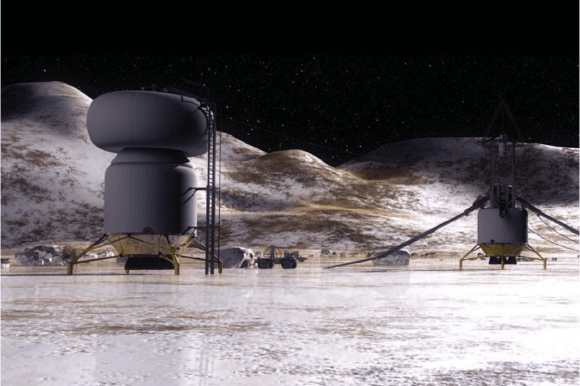
The study proposed a possible surface base on Callisto where a crew could “teleoperate a Europa submarine and excavate Callisto surface samples near the impact site”. In addition, this base could extract water from Callisto’s ample supply of water ices to produce rocket propellant for further exploration of the Solar System.
The advantages of a base on Callisto include low radiation (due to its distance from Jupiter) and geological stability. Such a base could facilitate exploration on other Galilean Moons, and be an ideal location for a Jovian system way station, servicing spacecraft heading farther into the outer Solar System – which would likely take the form of craft using a gravity assist from a close flyby of Jupiter.
Reports filed by NASA’s Glenn Research Center and Langley Research Center – in December and February of 2003, respectively – both outlined possible manned missions to Callisto, as envisioned by HOPE. According to these reports, a mission that would likely involve a ship using a Mangetoplasmadynamic (MPD) or Nuclear-Electric Propulsion (NEP) drive system, and equipped to generate artificial gravity, could be mounted in the 2040s.
So while Callisto may not be the best target in the search for extra-terrestrial life, it may be the most hospitable of Jupiter’s moons for human life. In either case, any future missions to Jupiter will likely include a stopovers to Callisto, with the intent of investigating both of these possibilities.
We have many great articles on Callisto, Jupiter, and its system of moons here at Universe Today. Here’s one about how impacts effected Callisto’s interior, And here is one on all of the Galilean Moons.
For more information, check out NASA’s Solar System Exploration page on Callisto.
Astronomy Cast offers has a good episode on the subject, titled Episode 57: Jupiter’s Moons.

